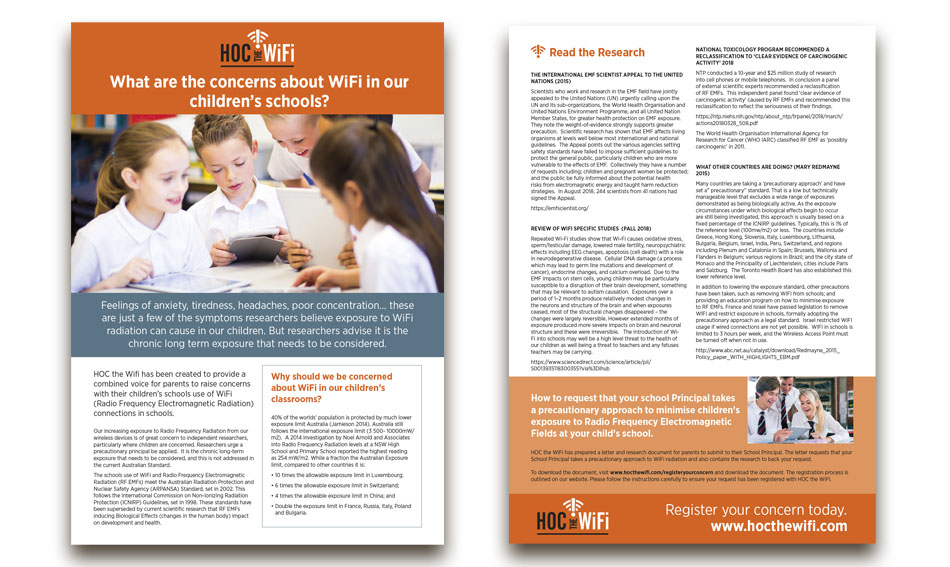Why should we be concerned about WiFi in our children’s class rooms?
Other countries have heeded the warnings of scientific research, and reduced limits to 1% or less than Australian Exposure limit. The Australian RF EMF exposure limit remains well above that of many countries around the world. In some cases, our children classrooms RF radiation levels are twice the level children would be allowed to be exposed to in other countries such as Italy, Poland and France.
Technology has revolutionised the way that we communicate and learn, including in our children’s classrooms. WiFi uses Radio Frequency Electromagnetic Radiation (RFR) to transmit and receive information, eliminating the use of cables.
Our increasing exposure to Radio Frequency Radiation from our wireless devices is of great concern to independent researchers, particularly where children are concerned. Researchers urge a precautionary principal be applied (EMF Scientists Appeal 2015). This generation will be the first generation exposed Radio Frequency Radiation as a constant throughout their lives. Australia has not acted to minimise exposures the way many other countries have. The Australian Government advice conflicts with advice from other Governments around the world (Redmayne 2015, McLean, 2017).
A 2014 investigation by Noel Arnold and Associates into Radio Frequency Radiation levels at a NSW High School and Primary School reported the highest reading as 254 mW/m2. While a fraction the Australian Exposure limit, compared to other countries it is:
- 10 times the allowable exposure limit in Luxembourg;
- 6 times the allowable exposure limit in Switzerland;
- 4 times the allowable exposure limit in China; and
- Double the exposure limit in France, Russia, Italy, Poland and Bulgaria.
While radiation levels in our schools are within the Australian Standard, these levels are not allowed in some other countries, let alone in classrooms.
Scientific research observing biological effects (changes in the body) have resulted in some other countries reducing their exposure limit to just 1% or less than Australia’s. 40% of the worlds’ population is protected by much lower exposure limit than we are in Australia (Jamieson 2014). Some countries have banned WiFi in classrooms and taken steps to reduce radiation exposure, these countries include Cyprus, France, Belgium and Israel (Environmental Health Trust 2018, Redmayne 2016). Some countries have education programs to reduce personal exposure (Redmayne, 2016).
Researchers advise it is the chronic long term exposure that needs to be considered, and this is not addressed in the current Australian Standard (Bijlsma 2017 , Jamieson 2014, Redmayne 2015, McLean 2017, BioInitiative Report 2017, EMF Scientists Appeal 2015).
At HOC the WiFi we understand the use of technology in schools is important. Wired Ethernet connections give the same network connection and learning experience, it is the use Radio Frequency Radiation that is of concern.
Many parents have expressed their concerns to their schools, however too often concerns are dismissed with the response that the school is meeting the Australian Standard.
Many schools do meet the Australian Standard, so what can we do to protect children in our schools?
REFERENCES
Bijlsma, N. (2012). Healthy Home, Healthy Family. Buddina, Australia, Joshua Books.
Bio initiative Report. (2012). “Conclusions: Defining a new ‘Effect Level’ for RFR” http://www.bioinitiative.org/conclusions/
Environmental Health Trust (2018). Schools Worldwide Removing the WiFi and reducing exposure. Retrieved 2/1/2019. https://ehtrust.org/schools-worldwide-removing-wifi-reducing-exposure/
International EMF Scientist (2015). “International Appeal Scientists call for Protection from Non-ionizing Electromagnetic Field Exposure.” https://emfscientist.org/
Jamieson, I. (2014). “RF/Microwave radiation risk awareness.”
From http://www.eesc.europa.eu/resources/docs/emf_report_-provided-by-dr-jamieson.pdf
McLean, L (2017). Wireless Wise Families. Scribe Publications. Brunswick, Australia.
Noel Arnold and Associates (2014). Radio Frequency Radiation Assessment. Retrieved 6th March 2017 from http://www.lism.catholic.edu.au/wp-content/uploads/2014/10/WiFi-RFR-Assessment-CSO-Lismore-July-2014.pdf
Pall.M.L (2018). Wi-Fi is an important threat to human Health. Environ Res. 164:405-416. DOI: 10.1016. Retrieved December 2018. https://www.sciencedirect.com/science/article/pii/S0013935118300355?via%3Dihub
Redmayne, M. (2015). “International policy and advisory response regarding children’s exposure to radio frequency electromagnetic fields (RF-EMF).” Electromagn Biol Med: 1-9. http://www.abc.net.au/catalyst/download/Redmayne_2015_Policy_paper_WITH_HIGHLIGHTS_EBM.pdf
Redmayne, M. (2015). Wireless devices: Risk, regulation, compliance and liability. Children’s and workers exposure to radiofrequencies: International approaches to policy and advice. UNSW, Faculty for Law. Wireless devices: Risk, Regulation, Compliance and Liability.
Take action and register your concern
Let Your School know you would like a precautionary approach and education program at your school

Download our information flyer
This informative A4 size information flyer has been designed as a handout to help inform people of the risks of WiFi radiation.
